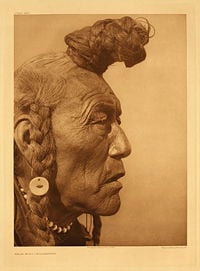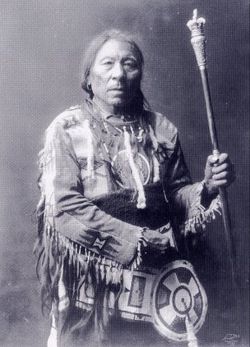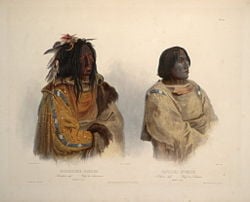Difference between revisions of "Blackfoot" - New World Encyclopedia
({{Contracted}}) |
Nancy Hinson (talk | contribs) |
||
| Line 21: | Line 21: | ||
It is also speculated that "Blackfoot Cherokee" refers to a band of Cherokees that had black ancestry, most likely from the adoption of escaped slaves into their society. This band of Cherokees of course have no connection to the Blackfoot nations. | It is also speculated that "Blackfoot Cherokee" refers to a band of Cherokees that had black ancestry, most likely from the adoption of escaped slaves into their society. This band of Cherokees of course have no connection to the Blackfoot nations. | ||
| + | ==Blackfoot history== | ||
| + | Archaolgists have identified evidence of early native ancestors to have arrived after the Pleistocene Glaciers disappeared aproximately 11,000 years ago. Permanent residents have been found between 3,000 to 5,000 years ago. These natives spoke the Algonkian language. The Blackfoot Nation comprises the lineages from these early people. <ref> http://www.uleth.ca/vft/Oldman_River/NativeHistory.html. Retrieved on March 23, 2007.</ref> | ||
| − | ==Blackfoot | + | The confederation in the United States and Canada were made up of three groups: The Northern Blackfoot or Siksika, the Kainah or Blood, and the Peigan. This structure was not an authoritative political system as such but brought the groups together for ceremonial gatherings and summer hunting. Buffalo were often hunted in drives that sent stampeding herds over steep cliffs killing them in large numbers.<ref> http://lucy.ukc.ac.uk/EthnoAtlas/Hmar/Cult_dir/Culture.7833. |
| + | Retrieved on March 23, 2007.</ref> | ||
| + | |||
| + | The Blackfoot, like other Plains Indians of North America, lived without horses for thousands of years while still maintaining a hunter/gatherer way of life. Horses were introduced around 1730. Following this, the strength and prowess of their warrior society became a powerful force called "aiinikiks" or "All-Comrades". This was a closely guarded membership structure. Each society had its own songs and dances. <ref> http://www.utexas.edu/courses/wilson/ant304/projects/projects98/krochenskip/krochenskip.html. Retrieved on March 23, 2007. </ref> | ||
| + | |||
| + | ==Blackfoot culture== | ||
The Blackfoot were fiercely independent and very successful warriors whose territory stretched from the [[North Saskatchewan River]] along what is now [[Edmonton, Alberta]] in [[Canada]], to the [[Yellowstone River]] of Montana, and from the [[Rocky Mountains]] and along the [[Saskatchewan]] river past Regina. | The Blackfoot were fiercely independent and very successful warriors whose territory stretched from the [[North Saskatchewan River]] along what is now [[Edmonton, Alberta]] in [[Canada]], to the [[Yellowstone River]] of Montana, and from the [[Rocky Mountains]] and along the [[Saskatchewan]] river past Regina. | ||
| Line 37: | Line 44: | ||
The Blackfoot maintained this traditional way of life based on hunting bison, until the near [[extinction]] of the bison by [[1881]] forced them to adapt their ways of life in response to the effects of the [[European colonization of the Americas|European settlers]] and their descendants. In the United States, they were restricted to land assigned in the [[Treaty of Fort Laramie (1851)|Fort Laramie Treaty of 1851]] and were later given a distinct reservation in the [[Sweetgrass Hills Treaty]] of 1887. In [[1877]], the Canadian Blackfoot signed [[Treaty 7]], and settled on [[Indian reserve|reserves]] in southern Alberta. This began a period of great struggle and economic hardship, as the Blackfoot had to try to adapt to a completely new way of life, as well as suffer exposure to many [[diseases]] their people had not previously encountered. Eventually, they established a viable economy based on farming, ranching, and light industry, and their population has increased to about 16,000 in Canada and 15,000 in the U.S. today. With their new economic stability, the Blackfoot have been free to adapt their culture and traditions to their new circumstances, renewing their connection to their ancient roots. | The Blackfoot maintained this traditional way of life based on hunting bison, until the near [[extinction]] of the bison by [[1881]] forced them to adapt their ways of life in response to the effects of the [[European colonization of the Americas|European settlers]] and their descendants. In the United States, they were restricted to land assigned in the [[Treaty of Fort Laramie (1851)|Fort Laramie Treaty of 1851]] and were later given a distinct reservation in the [[Sweetgrass Hills Treaty]] of 1887. In [[1877]], the Canadian Blackfoot signed [[Treaty 7]], and settled on [[Indian reserve|reserves]] in southern Alberta. This began a period of great struggle and economic hardship, as the Blackfoot had to try to adapt to a completely new way of life, as well as suffer exposure to many [[diseases]] their people had not previously encountered. Eventually, they established a viable economy based on farming, ranching, and light industry, and their population has increased to about 16,000 in Canada and 15,000 in the U.S. today. With their new economic stability, the Blackfoot have been free to adapt their culture and traditions to their new circumstances, renewing their connection to their ancient roots. | ||
| − | |||
| − | |||
| − | |||
| − | |||
| − | |||
| − | |||
| − | |||
| − | |||
==Footnotes== | ==Footnotes== | ||
Revision as of 23:48, 23 March 2007
| Blackfoot |
|---|
| Bear Bull |
| Total population |
| 32,000 |
| Regions with significant populations |
| Canada (Alberta) United States (Montana) |
| Languages |
| English, Blackfoot |
| Religions |
| Christianity, other |
| Related ethnic groups |
| other Algonquian peoples |
The Blackfoot Confederacy is the collective name of three First Nations in Alberta and one Native American tribe in Montana.
The Blackfoot Confederacy consists of the North Peigan (Aapatohsipiikanii), the South Peigan (Aamsskaapipiikanii), the Kainai Nation (Blood), and the Siksika Nation ("Blackfoot") or more correctly Siksikawa ("Blackfoot people"). The South Peigan are located in Montana, and the other three are located in Alberta. Together they call themselves the Niitsitapii (the "Real People"). These groups shared a common language and culture, had treaties of mutual defense, and freely intermarried.
It is also speculated that "Blackfoot Cherokee" refers to a band of Cherokees that had black ancestry, most likely from the adoption of escaped slaves into their society. This band of Cherokees of course have no connection to the Blackfoot nations.
Blackfoot history
Archaolgists have identified evidence of early native ancestors to have arrived after the Pleistocene Glaciers disappeared aproximately 11,000 years ago. Permanent residents have been found between 3,000 to 5,000 years ago. These natives spoke the Algonkian language. The Blackfoot Nation comprises the lineages from these early people. [1]
The confederation in the United States and Canada were made up of three groups: The Northern Blackfoot or Siksika, the Kainah or Blood, and the Peigan. This structure was not an authoritative political system as such but brought the groups together for ceremonial gatherings and summer hunting. Buffalo were often hunted in drives that sent stampeding herds over steep cliffs killing them in large numbers.[2]
The Blackfoot, like other Plains Indians of North America, lived without horses for thousands of years while still maintaining a hunter/gatherer way of life. Horses were introduced around 1730. Following this, the strength and prowess of their warrior society became a powerful force called "aiinikiks" or "All-Comrades". This was a closely guarded membership structure. Each society had its own songs and dances. [3]
Blackfoot culture
The Blackfoot were fiercely independent and very successful warriors whose territory stretched from the North Saskatchewan River along what is now Edmonton, Alberta in Canada, to the Yellowstone River of Montana, and from the Rocky Mountains and along the Saskatchewan river past Regina.
The basic social unit of the Blackfoot, above the family, was the band, varying from about 10 to 30 lodges, about 80 to 240 people. This size of group was large enough to defend against attack and to undertake small communal hunts, but was also small enough for flexibility. Each band consisted of a respected leader, possibly his brothers and parents, and others who need not be related. Since the band was defined by place of residence, rather than by kinship, a person was free to leave one band and join another, which tended to ameliorate leadership disputes. As well, should a band fall upon hard times, its members could split-up and join other bands. In practice, bands were constantly forming and breaking-up. The system maximized flexibility and was an ideal organization for a hunting people on the Northwestern Plains.
During the summer the people assembled for tribal gatherings. In these large assemblies, warrior societies played an important role. Membership into these societies was based on brave acts and deeds.
Blackfoot people were nomadic, following the buffalo herds. Survival required their being in the proper place at the proper time. For almost half the year in the long northern winter, the Blackfoot people lived in their winter camps along a wooded river valley perhaps a day's march apart, not moving camp unless food for the people and horses or firewood became depleted. Where there was adequate wood and game resources, some bands might camp together. During this part of the year, buffalo wintered in wooded areas where they were partially sheltered from storms and snow, which hampered their movements, making them easier prey. In spring the buffalo moved out onto the grasslands to forage on new spring growth. The Blackfoot did not follow immediately, for fear of late blizzards, but eventually resources such as dried food or game became depleted, and the bands would split up and begin to hunt the buffalo.
In mid-summer, when the Saskatoon berries ripened, the people regrouped for their major tribal ceremony, the Sun Dance. This was the only time of year when the entire tribe would assemble, and served the social purpose of reinforcing the bonds between the various groups, and reidentifying the individuals with the tribe. Communal buffalo hunts provided food and offerings of the bulls' tongues (a delicacy) for the ceremonies. After the Sun Dance, the people again separated to follow the buffalo.
In the fall, the people would gradually shift to their wintering areas and prepare the buffalo jumps and pounds. Several groups of people might join together at particularly good sites, such as Head-Smashed-In Buffalo Jump. As the buffalo were naturally driven into the area by the gradual late summer drying off of the open grasslands, the Blackfoot would carry out great communal buffalo kills, and prepare dry meat and pemmican to last them through winter, and other times when hunting was poor. At the end of the fall, the Blackfoot would move to their winter camps.
The Blackfoot maintained this traditional way of life based on hunting bison, until the near extinction of the bison by 1881 forced them to adapt their ways of life in response to the effects of the European settlers and their descendants. In the United States, they were restricted to land assigned in the Fort Laramie Treaty of 1851 and were later given a distinct reservation in the Sweetgrass Hills Treaty of 1887. In 1877, the Canadian Blackfoot signed Treaty 7, and settled on reserves in southern Alberta. This began a period of great struggle and economic hardship, as the Blackfoot had to try to adapt to a completely new way of life, as well as suffer exposure to many diseases their people had not previously encountered. Eventually, they established a viable economy based on farming, ranching, and light industry, and their population has increased to about 16,000 in Canada and 15,000 in the U.S. today. With their new economic stability, the Blackfoot have been free to adapt their culture and traditions to their new circumstances, renewing their connection to their ancient roots.
Footnotes
- ↑ http://www.uleth.ca/vft/Oldman_River/NativeHistory.html. Retrieved on March 23, 2007.
- ↑ http://lucy.ukc.ac.uk/EthnoAtlas/Hmar/Cult_dir/Culture.7833. Retrieved on March 23, 2007.
- ↑ http://www.utexas.edu/courses/wilson/ant304/projects/projects98/krochenskip/krochenskip.html. Retrieved on March 23, 2007.
External links
Credits
New World Encyclopedia writers and editors rewrote and completed the Wikipedia article in accordance with New World Encyclopedia standards. This article abides by terms of the Creative Commons CC-by-sa 3.0 License (CC-by-sa), which may be used and disseminated with proper attribution. Credit is due under the terms of this license that can reference both the New World Encyclopedia contributors and the selfless volunteer contributors of the Wikimedia Foundation. To cite this article click here for a list of acceptable citing formats.The history of earlier contributions by wikipedians is accessible to researchers here:
The history of this article since it was imported to New World Encyclopedia:
Note: Some restrictions may apply to use of individual images which are separately licensed.


